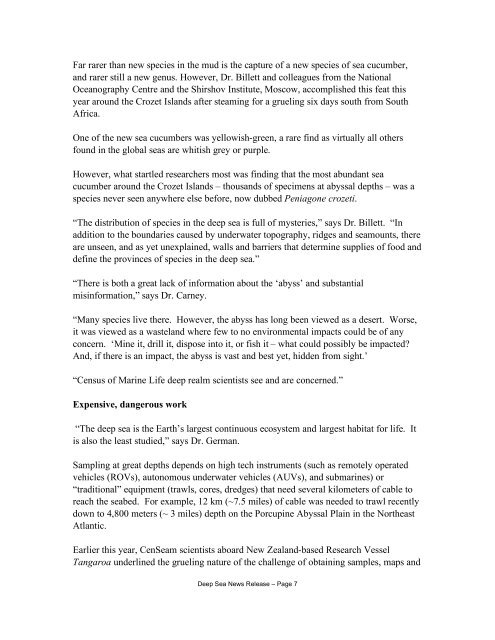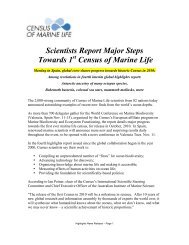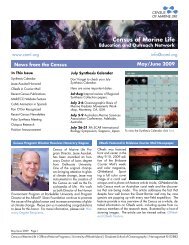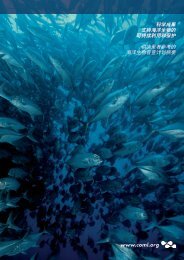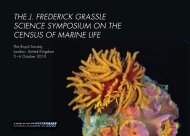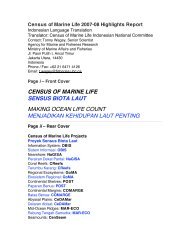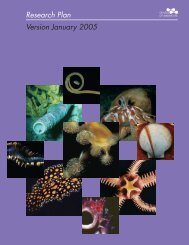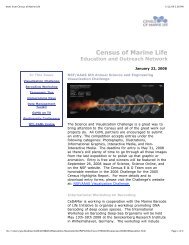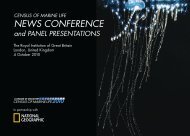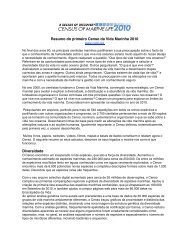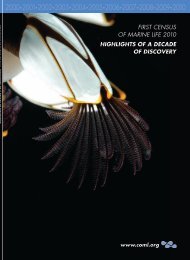From the Edge of Darkness to the Black Abyss - Census of Marine Life
From the Edge of Darkness to the Black Abyss - Census of Marine Life
From the Edge of Darkness to the Black Abyss - Census of Marine Life
Create successful ePaper yourself
Turn your PDF publications into a flip-book with our unique Google optimized e-Paper software.
Far rarer than new species in <strong>the</strong> mud is <strong>the</strong> capture <strong>of</strong> a new species <strong>of</strong> sea cucumber,and rarer still a new genus. However, Dr. Billett and colleagues from <strong>the</strong> NationalOceanography Centre and <strong>the</strong> Shirshov Institute, Moscow, accomplished this feat thisyear around <strong>the</strong> Crozet Islands after steaming for a grueling six days south from SouthAfrica.One <strong>of</strong> <strong>the</strong> new sea cucumbers was yellowish-green, a rare find as virtually all o<strong>the</strong>rsfound in <strong>the</strong> global seas are whitish grey or purple.However, what startled researchers most was finding that <strong>the</strong> most abundant seacucumber around <strong>the</strong> Crozet Islands – thousands <strong>of</strong> specimens at abyssal depths – was aspecies never seen anywhere else before, now dubbed Peniagone crozeti.“The distribution <strong>of</strong> species in <strong>the</strong> deep sea is full <strong>of</strong> mysteries,” says Dr. Billett. “Inaddition <strong>to</strong> <strong>the</strong> boundaries caused by underwater <strong>to</strong>pography, ridges and seamounts, <strong>the</strong>reare unseen, and as yet unexplained, walls and barriers that determine supplies <strong>of</strong> food anddefine <strong>the</strong> provinces <strong>of</strong> species in <strong>the</strong> deep sea.”“There is both a great lack <strong>of</strong> information about <strong>the</strong> ‘abyss’ and substantialmisinformation,” says Dr. Carney.“Many species live <strong>the</strong>re. However, <strong>the</strong> abyss has long been viewed as a desert. Worse,it was viewed as a wasteland where few <strong>to</strong> no environmental impacts could be <strong>of</strong> anyconcern. ‘Mine it, drill it, dispose in<strong>to</strong> it, or fish it – what could possibly be impacted?And, if <strong>the</strong>re is an impact, <strong>the</strong> abyss is vast and best yet, hidden from sight.’“<strong>Census</strong> <strong>of</strong> <strong>Marine</strong> <strong>Life</strong> deep realm scientists see and are concerned.”Expensive, dangerous work“The deep sea is <strong>the</strong> Earth’s largest continuous ecosystem and largest habitat for life. Itis also <strong>the</strong> least studied,” says Dr. German.Sampling at great depths depends on high tech instruments (such as remotely operatedvehicles (ROVs), au<strong>to</strong>nomous underwater vehicles (AUVs), and submarines) or“traditional” equipment (trawls, cores, dredges) that need several kilometers <strong>of</strong> cable <strong>to</strong>reach <strong>the</strong> seabed. For example, 12 km (~7.5 miles) <strong>of</strong> cable was needed <strong>to</strong> trawl recentlydown <strong>to</strong> 4,800 meters (~ 3 miles) depth on <strong>the</strong> Porcupine <strong>Abyss</strong>al Plain in <strong>the</strong> Nor<strong>the</strong>astAtlantic.Earlier this year, CenSeam scientists aboard New Zealand-based Research VesselTangaroa underlined <strong>the</strong> grueling nature <strong>of</strong> <strong>the</strong> challenge <strong>of</strong> obtaining samples, maps andDeep Sea News Release – Page 7


